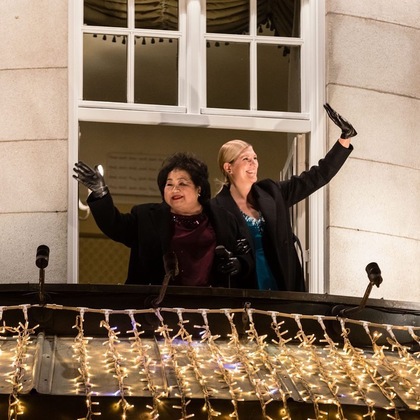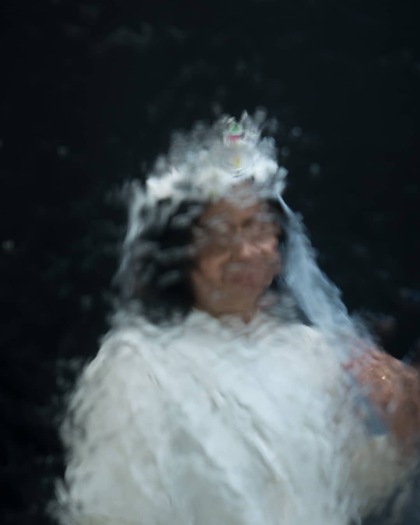
R
E
V N
E
X
T
Australian non-profit Artspace Sydney launched “52 Artists 52 Actions” to provide a platform for artists to engage with political and social issues. All images via the @52 Artists 52 Actions Instagram.
As social media is increasingly used for targeted advertising and propagating reactionary political messages, is there a way for artists to push back against these twin currents? And what is the potential of social media platforms for artists engaged with political and social issues? Those are the questions and concerns Artspace Sydney is exploring in 2018 with its year-long “52 Artists 52 Actions” project, for which the art organization is inviting artists and collectives from 33 countries to highlight issues important to them by staging unique actions in, or about, specific locations across the Asia-Pacific region.
As part of the project, each artist takes over the @52artists52actions Instagram account for one week. Richard Bell kicked things off in January by celebrating Australia’s first-ever Nobel Peace Prize winner, The International Campaign to Abolish Nuclear Weapons (ICAN), which Australian prime minister Malcolm Turnbull has refused to acknowledge. Hera Büyüktaşçıyan used the following week for posts about Istanbul’s minority communities, marking the anniversary of Turkish-Armenian journalist Hrant Dink’s assassination on January 19, 2007. Heman Chong looked at the history of non-violent resistance during his week on the handle (3/12–18), with posts including excerpts of articles from the Straits Times in 2000 about Singapore arts organizations’ “No Art Day” protest against government censorship. The collective Chim↑Pom (3/19–26) explored the Japanese government’s crackdown on nightlife districts and displays of nudity as Tokyo prepares to host the 2020 Olympics.
Project curator Talia Linz told ArtAsiaPacific that the origins of “52 Artists 52 Actions” lay in “the concerning, recent shifts in the global political atmosphere and a shift (backwards) to conservatism,” which have “galvanized communities around social and political change through collective action.” The project also utilizes other aspects inherent to the medium, such as what Linz calls social media’s “place-less space,” in order “to facilitate a larger speculation about Asia, and Australia’s relationship to it, beyond geography.”
Linz acknowledges that the project is an experiment for Artspace and all those involved: “We really had no set idea about how the project would pan out, and coming into its 16th week [at time of writing], we’ve been delighted by the diverse approaches from artists—some dealing with the nature of the medium itself, others with the particularities of their unique social, political, historical etc. circumstances.”
For many artists, the political is intimately entwined with personal stories, to which social media is well suited. Last week’s artist [at time of writing], Sawangwongse Yawnghwe, who is originally from the Shan state in Myanmar, began by announcing that his action “will be to bear witness through visual exploration to the ongoing military abuses in Burma/Myanmar,” with posts including drawings of persecuted figures, as well as animated text enumerating recent atrocities and crimes, and spelling out messages like “Pay Attention Mother Fuckers.”
That struggle over attention is one of the biggest issues around how social media has transformed daily life. Dhaka-based artist Reetu Sattar, in her early April campaign (4/9–15), wanted to counter what she called social media’s inequitable “economy of attention” by posting reflective, personal portraits of her own mother.
Artists including Samson Young from Hong Kong, Enkhjargal Ganbat of Mongolia, and Fazal Rizvi from Pakistan are participating in the coming weeks, along with dozens of others through January 2019. The project’s website contains more detailed information about each artist, their works and the process behind their posts. At the conclusion of the year, the project will ultimately be compiled in book form as an “encyclopedia” and published in mid-2019 by Thames & Hudson.
Linz says that so far, the project has yielded several insights about Instagram as a platform: “The perception of the medium is perhaps that it’s only conducive to quick scrolling, but many followers really engage with the contextual information and comments too, facilitating a two-way conversation between artist and audience.” While it is perhaps too optimistic to believe that artists’ posts will reorient the direction of Instagram itself, the project offers its followers previously unknown or unexpected perspectives beyond their self-curated feeds. No matter where in the world you or the artists are, “52 Artists 52 Actions” is a daily reminder that there are others out there wrestling with issues not so different than our own.
HG Masters is ArtAsiaPacific’s editor-at-large.
To read more of ArtAsiaPacific’s articles, visit our Digital Library.





